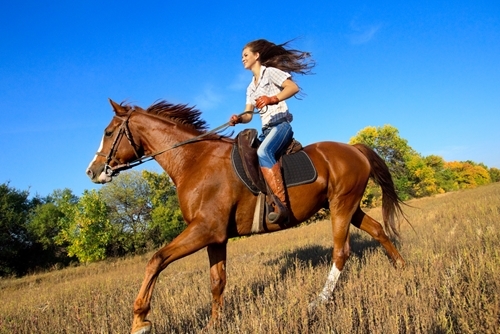As is the case with human beings, groups of horses – or herds – have a certain hierarchy. Components like age, gender and overall health and physical durability can dictate which horses are leaders and which are more subservient followers. More recently, though, scientists have found another contributor to a horses’ overall place in the herd: the animal’s weight.Obesity is a factor
According to a study published in the journal Applied Animal Behaviour Science, those horses that are found to be obese are often more dominant than the leaner herdmates. Researchers from the U.K.’s WALTHAM Center for Pet Nutrition and University of Bristol looked at 194 horses from 42 distinct herds, with each animal having variations in height, weight and age. Using a nine-point scale – with seven or higher earning a classification of obese – the researchers evaluated the physical condition of each horse.
From there, they then attempted to rank each horse’s overall dominance to one another by running a feeding trial. This test involves distributing certain portions of food – namely hay and certain kinds of feed – and then recording from when the first horse eats to when the food was fully and completely finished. In order to balance the test, the research team made note of several displacements, like when horses moved between certain sets of food. Among the results, the team found the following:
- Nearly 18 percent of the horses were overweight. The mean body condition for this sample herd was 5.53.
- Smaller animals – like ponies – are more likely to be obese than any larger counterparts.
- There’s little correlation between the age and body condition. However, a larger percent of middle-aged animals appeared to be dominant.
- Those herds with similar age levels and heights had a larger number of what the team called food-related displacement interactions. That is, more issues like food being stolen or horses not getting equal time to eat.
- The higher the rank or level of dominance, the higher horse’s overall body condition. For every one unit higher a horse ranked in dominance, the odds for obesity increased by 12 percent.
The team said this info helped to offer new ideas about the relationship between dominance and obesity. In turn, more breeders and trainers can use knowledge to manage the feed intake of any high-risk, dominant horses.
In 1986, researchers J. Maynard Smith and R. W. L. Brown came to a similar conclusion as the WALTHAM-Bristol researchers. Specifically, Smith and Brown found that putting horses together by varying ages and heights can help reduce dominance-related injuries and create better overall interactivity.
The issues surrounding horse obesity
In recent years, obesity has become an increasing concern for most humans. However, according to the University of Missouri, not enough owners find a problem with obesity in horses. The obesity concern has risen over the last decade or so; in fact, as Science Daily reported, nearly 51 percent of all horses run the risk of becoming obese. Like humans, these dangerously overweight horses can suffer from a number of health concerns, including:
- Laminitis: A horse’s extra weight can put added pressure on the animal’s hooves. This, in turn, can often prevent the horse from using the affected foot.
- Hyperinsulinemia: In which the horse’s body is resistant to insulin. This dynamic can affect a horses’ heart, pancreas and nervous system. Common symptoms include chronic infections, cresty neck and intermittent depression.
- Oxidative stress: This refers to a malady that occurs after changes to the horses’ metabolic processes. This stress can lead to the increased destruction of a horse’s body cells, which can affect any number of the animal’s bodily systems.
Obese horses also have any number of issues with both joint and muscle health.
Exercise and supplements
On the one hand, exercise is crucial in reducing the risk of obesity, as it helps stimulate fat burning systems and can improve cardiovascular parameters. To further aid in the horses’ ongoing health, owners may also want to consider the use of certain supplements. As a horse exercises regularly, the vitamins within JC’s X-Tie Up™ can help promote healthier muscle function. Meanwhile, Orange-A-Day™ can promote more efficient use of electrolytes and healthy hydration, a crucial factor for any sustained activity.









